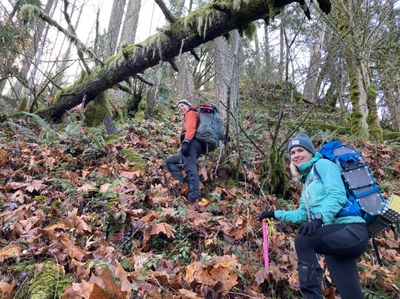
Trip Report
Winter Scramble Review - West Tiger Mountain
Tiger Mountain was a surprisingly good setting to serve as a segue to Winter Scrambles. A variety of navigation challenges, lots of conditioning (5000’, 15 miles), made even more enjoyable (and possible) by its close proximity to home (less time driving).
- Sat, Nov 20, 2021
- Winter Scramble - West Tiger Mountain Railroad Grade
- West Tiger Mountain Railroad Grade
- Scrambling
- Successful
-

- Road suitable for all vehicles
-
Surprisingly accommodating from an enjoyment perspective (no rain, gentle winds, cool temps and no snow or ice). Nastier weather (and/or ice/snow) would have added to the ‘Winter Scramble Review’ realism, but probably would have made a long day even longer.
Our day was centered on two maps, one showing our overall route (with numbered labels indicating our progression throughout the day):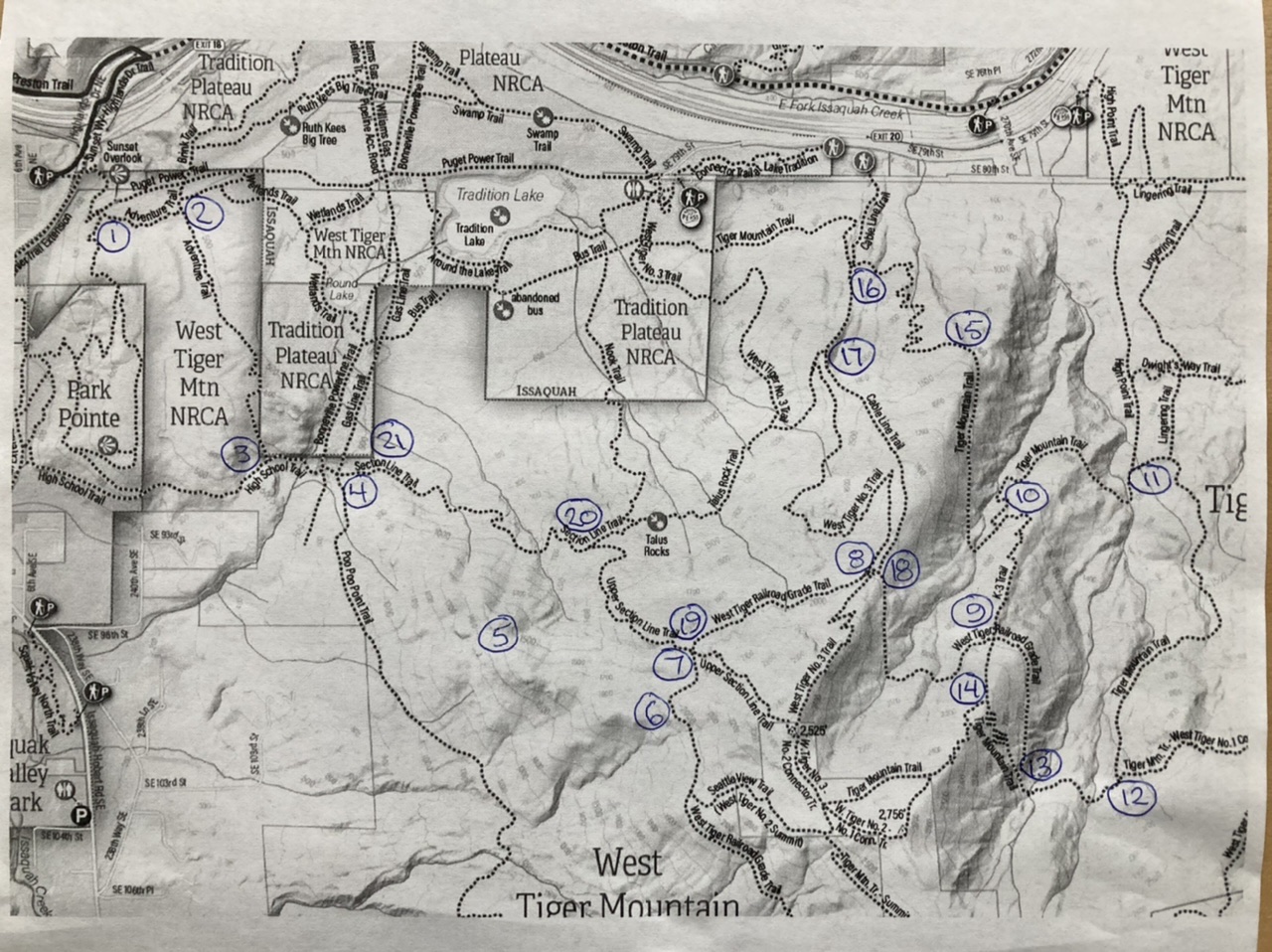
and the other a detailed topographic map (albeit out of date) of the ridge hosting a cross country travel section (situated between the Section Line and Poo Poo Point trails, indicated on the first map between the labels 4,5,6):
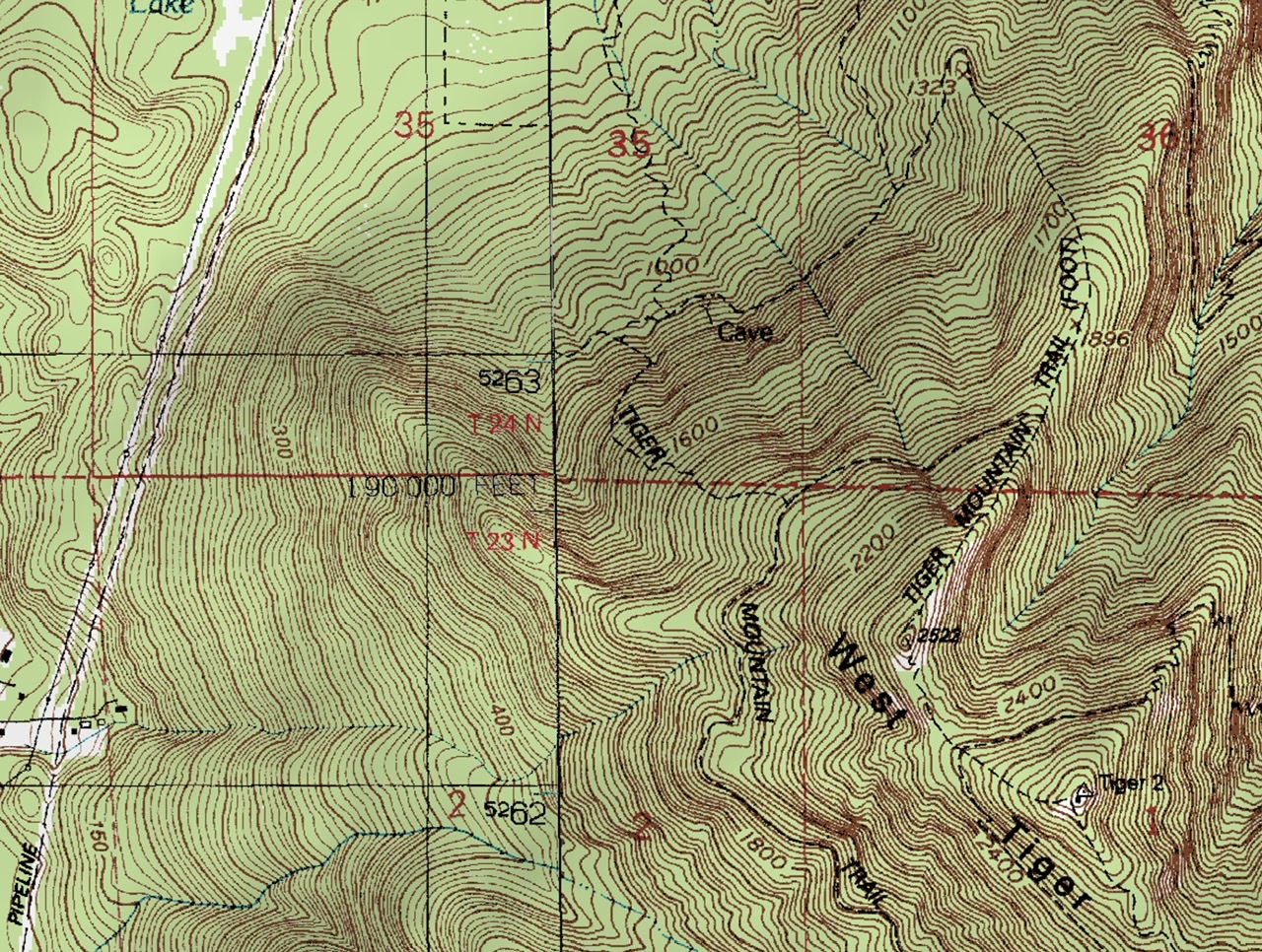
At the cars folks were encouraged to a) dispense with poles, b) avoid using GPS devices (i.e. only navigate with map, compass, and altimeter throughout the day, even though we carried GPS devices. Note the accuracy comparison steps below), and c) when leading the group, to set a moderate pace compatible with keeping the party together during our 5000’ elevation gain/15 mile day. A reminder of our final 1000’ ascent of Cable Line at the end of a very long day (likely in the dark) helped emphasize the importance of a moderate/sustained pace.
At map label 1 each participant was given their own 8.5” x 11” paper copy of the two maps, and from that point on (until label 16) navigation decisions were not made by the leader. At each label we started out with each decision being collaborative, then changed at label 6 to each person taking their turn leading the group, making turn choices (confirmed by the group), as well as choosing the next leader. This venue (along with its available maps) was fortunate (for the purposes of this navigation practice) in having such poor signage and just acceptable maps (low resolution/inaccurate/meter-feet transition). An ideal situation for practicing navigation (especially with the artificial disuse of GPS tools to add drama).
We paused at label 4 (the intersection of the Poo Poo Point and Section Line trails) to discuss the utility of the Ice Axe w/Leash (Self Belay, Low Dagger), and trade offs relative to poles. We also spent some time building a spatial visualization of our day: a mostly cross country ascent of West Tiger 3, then a figure 8 of trail hiking NE of the W Tiger 3,2,1 ridge (the K-3 trail connecting the loops of the 8).
For our cross country travel we each took turns as the leader for 200’ vertical through brush that was at times quite dense with overlapping fallen logs and salal (Gaultheria shallon).
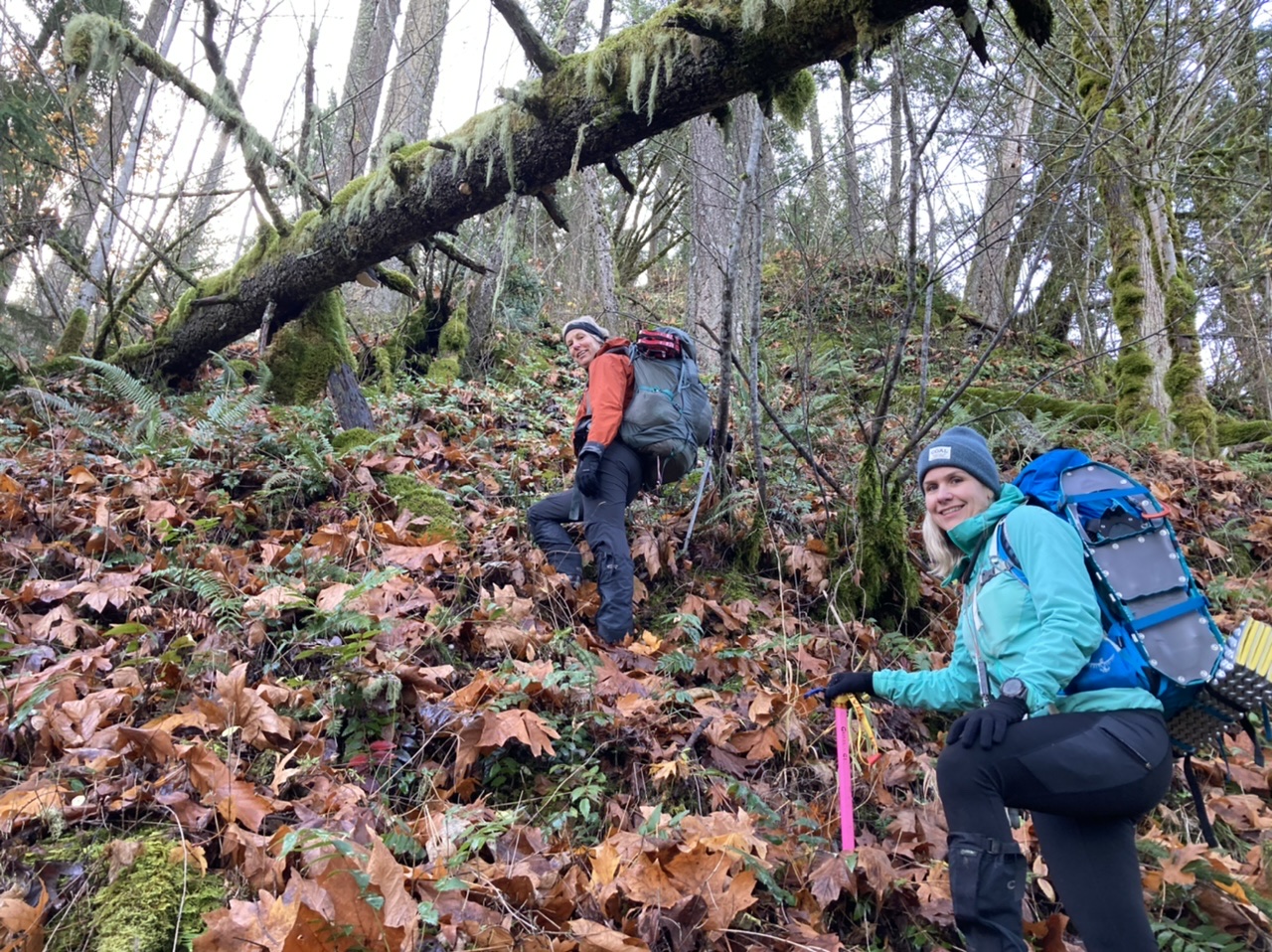
We followed a bearing of 135° to map label 5 (a forested summit/relative flat spot near 1700’) where we spent just under 3 hours reviewing each person’s equipment/clothing and their suitability to an unplanned bivouac in winter conditions (as one might encounter on a Winter Scramble ;). A technique for avoiding hypothermia in wet/cold conditions (provided to attendees previously, included at end of this trip report) helped drive these discussions along with the following tips:
- Mittens are much warmer than gloves.
- Windproof/waterproof mitten shells make mittens much warmer, irrespective of wet/dry status and mitten thickness.
- Line your pack with a heavy duty (3mm) garbage bag to ensure gear remains dry throughout the day.
- A completely redundant wool/synthetic full body layer: long john top & bottom, socks, mittens, balaclava/head-neck covering. This layer is not used during the day, remains at the bottom of the pack, and is only for emergencies (such as an accidental full body dunking in a stream).
- A long closed cell foam pad (at least 3/4 length) to insulate from the cold ground/snow in a prone position.
- Bivy Bag (to save weight, one without poles)
- Multiple pieces of emergency puffy gear (preferably synthetic) help you stay warm, even in the worst of conditions. A pair of puffy synthetic pants is particularly useful.
Although a party size smaller than our 7 would have reduced the time spent on these discussions, our lengthy day (due in no small part to these discussions) did reproduce a common trait of Winter Scrambles (a long day and return via head lamps).
Due to idle logging activities we visited West Tiger 3 via the upper Section Line trail:
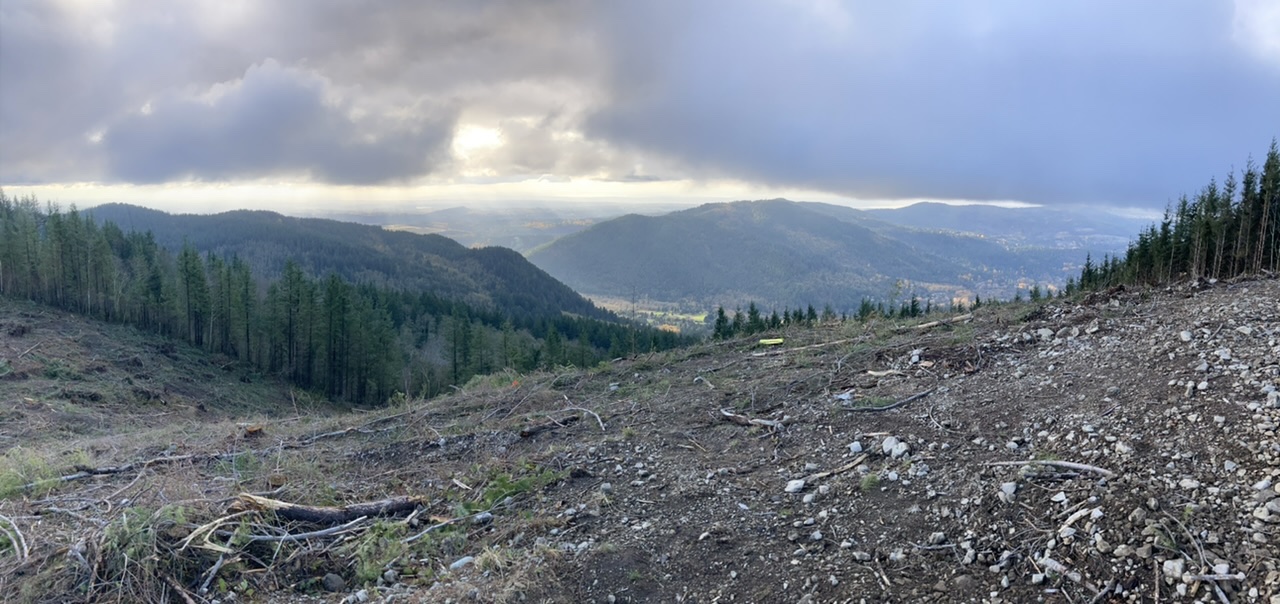
Sunset found us on the K-3 trail (for the 2nd time), and we all had our headlamps out by the time we reached the Cable Line trail (map label 16). After a break for food/water we plodded up our last 1000’ of elevation gain to the West Tiger Railroad Grade (map label 18), a very welcome and easy to miss turnoff (no signage) at ~2000’.
To expedite our return to the cars we dispensed with navigation discussions (some of us knew the way ;), and used the steep Section Line trail to quickly make our way back to map label 1 (the intersection/flat spot just above the parking area). After a final review of the fit/function of each person’s crampons and snowshoes (made particularly efficient by the late hour and the twinkling lights of Issaquah just below ;), we finally reached the parking area just after 8pm. A very welcome finish to our 13 hour day of 5000’ elevation gain over 15 miles.
Compass/SmartPhone Accuracy Exercise:
- Obtain the latitude/longitude for the location where you’re doing this exercise (work, home, wherever).
- Lookup the magnetic declination for that location here.
- Adjust your compass to have that declination.
- Adjust your compass for a bearing of due north.
- Lay your compass on the table pointing due north.
- Lay your phone on the table aligned with the compass, and using a compass utility (the compass app on iPhones), see how close your phone is to having the correct ‘True North’ bearing.
A Hypothermia Avoidance Technique (wet/cold conditions):
- Arrive at camp completely wet (along with most of your clothing).
- Spread out bivy sack with foam pad inside and dry base layer/emergency puffies inside.
- Take off all clothing (top/bottoms last, outside layers first, base layers last).
- As each item comes off, wring it out (twisting motion) with as much force as you can.
- As each item is dealt with, place it in bivy bag (separate from dry items).
- After removing your base layer top last, wring it dry, dry your entire body as best you can, then wring it again.
- Put on your dry base layer (top/bottom long johns, balaclava, socks, mittens) and climb inside bivy bag.
- Pull your previously wet but still damp base layer (just wrung out) over your dry layer.
- Pull on your dry puffy gear (parkas/pants), damp puffies can go inside sleeping bag (if you have one, damp puffies outside dry ones doesn’t work as it compresses the dry ones reducing their insulation value). If you don’t have a sleeping bag, lay the damp puffies over your dry ones.
- If all your puffies and sleeping bag are synthetic (very important), you (and all your gear) will be completely dry the following morning as your 98.6°F body heat will be driving out the water all night long. As the moisture makes it way out towards the open air (there is still lots of it in your damp clothing as well as the normal moisture your body gives off) it passes through all the intervening layers. Although down gear made with special fabrics (and brand new) might survive a night of this while still retaining some insulation value, the only sure thing (especially for used gear, or day after day situations) is to have everything be synthetic.
- The next morning all is dry. Put on your normal base layer/gear (emergency gear goes back in the pack inside the plastic garbage back). Repeats steps 1-10 each evening on wet days.
 Dave Morgan
Dave Morgan